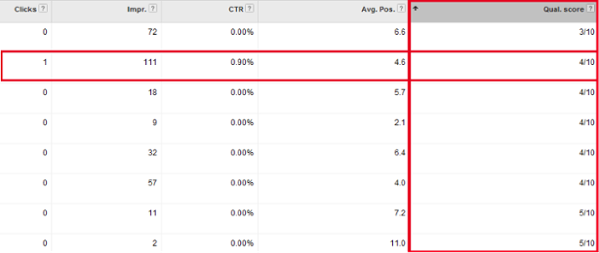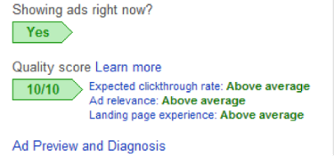[display-name-category]
[post_author]
Are you having issues with a low daily budget on such an expensive industry? Fortunately, it is possible to advertise under such conditions. An AdWords Campaign can be optimized according to your available resources. You can’t just simply decide not to advertise online, you need to make sure your campaign is being properly managed first. A low-budget campaign that is properly structured and optimized may provide better results than a high-budget campaign with bad structure and management. It is not only about how much money you invest in Google Ads but also about your individual ability to manage a campaign successfully. Even though there’s a vast amount of tools and data to consider when optimizing an AdWords campaign with a low budget, I want to summarize some of the best practices to help you optimize your campaigns.
1. Locate Keywords with Low-Quality Score
The lower your Quality Score, the more money you will pay per click. Most Advertisers do not even realize how much money they are actually losing by distributing their daily budget towards keywords with low-Quality Score. The reason why this happens is that they can’t even notice! A common best practice is to have the column for Quality Score show at all times. This way you will be able to spot low-Quality Scores and notice trends. At a campaign level, on the Keywords tab, click on the drop-down menu for columns and select “Customize Columns”. Proceed by selecting “Attributes” to add the Quality Score column.  Now that you have added this column, you should be able to sort all keywords by Quality Score from lowest to highest.
Now that you have added this column, you should be able to sort all keywords by Quality Score from lowest to highest.  For keywords with low-Quality Score that have a great number of impressions and relatively low CTR, you should add them to their own ad group. Remember, Google determines the Quality Score based on CTR, Ad Relevance, and Landing Pages. When specific keywords are added to their own Ad group, you have more control over all these three factors.
For keywords with low-Quality Score that have a great number of impressions and relatively low CTR, you should add them to their own ad group. Remember, Google determines the Quality Score based on CTR, Ad Relevance, and Landing Pages. When specific keywords are added to their own Ad group, you have more control over all these three factors.  Let’s assume you are selling shoes online. You may have an Ad group structured this way: Ad group: Shoes – Colors Keywords: Red Shoes, Blue Shoes, White Shoes, Black Shoes, and Green Shoes. If the keyword “Red Shoes” starts to trigger 500% more impressions than all other keywords in the same Ad group, you may want to consider adding this one to its own Ad group.
Let’s assume you are selling shoes online. You may have an Ad group structured this way: Ad group: Shoes – Colors Keywords: Red Shoes, Blue Shoes, White Shoes, Black Shoes, and Green Shoes. If the keyword “Red Shoes” starts to trigger 500% more impressions than all other keywords in the same Ad group, you may want to consider adding this one to its own Ad group.
2. Locate Low Performing Keywords with High CPCs
Since you have a limited budget available throughout the day, you need to make sure this budget is distributed wisely. By spending your budget on keywords with relatively low CPCs, the number of clicks throughout the day would be greater, increasing the chance to convert or generate leads. At a campaign level, you may want to sort your keywords by CPC from highest to lowest. This way you will find low performing keywords taking most of your daily budget throughout the day.
- Do any of these keywords have low CTR?
- If a keyword has a low-Quality Score, should I add it to its own ad group?
You need to consider how relevant these keywords are for your business, especially if limited by budget. If there are other close variations that have relatively lower CPC, you should strive for those instead. Notice you still need to consider keywords with high CPC, especially if these are converting keywords. You shouldn’t just narrow down your keyword list because these are “Expensive”, keep them while they are within your target CPA/ROI goals. If a Keyword has a relatively low CPC it means competition is low; most advertisers in your industry may not be using this particular keyword due to a low conversion rate.
3. How Much Are You Spending on Mobile Devices?
You need to consider how much of your budget is being distributed towards Mobile Devices only. At a campaign level, go to settings and select “Devices”.  According to this example, all of the conversions are coming from computers and tablets. Since the average position for Mobile Devices is relatively good when compared to computers and tablets, in this case you should reduce bids from mobile devices by %25 due to the high costs and no conversions and analyze again in 30 days. Notice mobile devices are not entirely excluded; it is important to acquire more data to further discuss if this should either be entirely excluded or not. On the other hand, you may have a higher conversion rate on mobile devices as compared to other networks:
According to this example, all of the conversions are coming from computers and tablets. Since the average position for Mobile Devices is relatively good when compared to computers and tablets, in this case you should reduce bids from mobile devices by %25 due to the high costs and no conversions and analyze again in 30 days. Notice mobile devices are not entirely excluded; it is important to acquire more data to further discuss if this should either be entirely excluded or not. On the other hand, you may have a higher conversion rate on mobile devices as compared to other networks:  For this particular case, you may want to lower your bids for Computers and bid more aggressively on Mobile Devices. Whether or not to bid lower for computers depend on what your goal is and your business strategy. If you can’t spend any more money and have to make the most out of what you have, you should lower your regular bids to 1/3 of what you’re bidding now. Subsequently, you then increase your mobile bids via a positive bid adjustment. In this case, I will set up a Bid Adjustment for Mobile Devices with a 300% increase. This way you will be spending less on Computers and distributing your daily budget mostly towards Mobile Devices. Remember to leverage mobile completely by creating mobile ads and take other steps to fully optimize your mobile AdWords advertising.
For this particular case, you may want to lower your bids for Computers and bid more aggressively on Mobile Devices. Whether or not to bid lower for computers depend on what your goal is and your business strategy. If you can’t spend any more money and have to make the most out of what you have, you should lower your regular bids to 1/3 of what you’re bidding now. Subsequently, you then increase your mobile bids via a positive bid adjustment. In this case, I will set up a Bid Adjustment for Mobile Devices with a 300% increase. This way you will be spending less on Computers and distributing your daily budget mostly towards Mobile Devices. Remember to leverage mobile completely by creating mobile ads and take other steps to fully optimize your mobile AdWords advertising.
4. Expand Your Negative Keyword List
Remember, you can’t afford to spend a budget on irrelevant traffic. As you acquire data, keep adding negative keywords. This way you will avoid spending money on people looking for something different than your product or service.  Click to Tweet: http://ctt.ec/081V9 Make sure you constantly look through the See Search Terms Report. At a campaign level, click on the drop-down menu for Details and select “All”.
Click to Tweet: http://ctt.ec/081V9 Make sure you constantly look through the See Search Terms Report. At a campaign level, click on the drop-down menu for Details and select “All”.  You will see a list of all search queries people have typed in to look up for your product or service. This is an effective way to find possible negative keywords. External factors affect your campaign performance as well. A new movie that just came out may have a similar name to your product or service; therefore, you need to add negative keywords accordingly to avoid showing your ads to people interested in this particular movie.
You will see a list of all search queries people have typed in to look up for your product or service. This is an effective way to find possible negative keywords. External factors affect your campaign performance as well. A new movie that just came out may have a similar name to your product or service; therefore, you need to add negative keywords accordingly to avoid showing your ads to people interested in this particular movie.
Focus First on Removing All Irrelevant Costs, Then Increase Budget
These are essential steps when optimizing AdWords Campaigns that are limited by budget. Once you go through all this information, you will be able to distribute your budget wisely. Remember, you can’t afford to send you a limited budget on irrelevant traffic and low performing keywords; therefore, you need to make sure you are optimizing your campaign accordingly. What other strategies do you use to optimize your AdWords while not going over your budget? What is your favorite/ most effective way to increase conversions and reduce irrelevant traffic?






